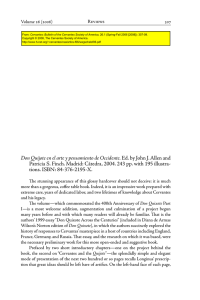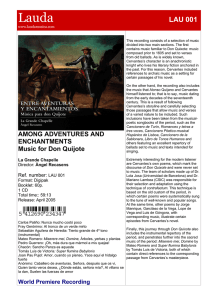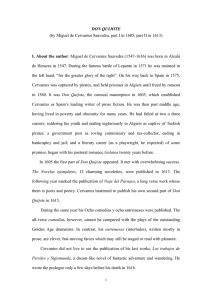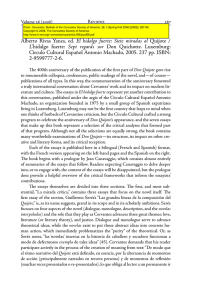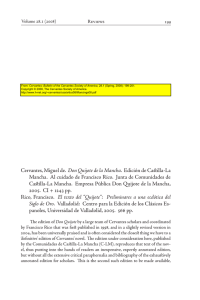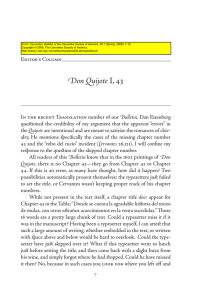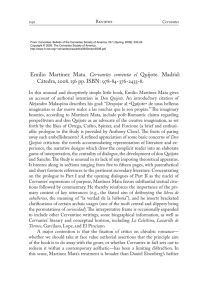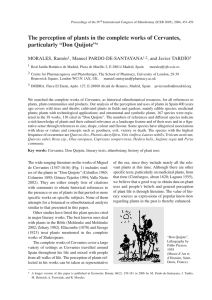Feliciano de Silva and His Romances of chivalry in Don Quijote
Anuncio
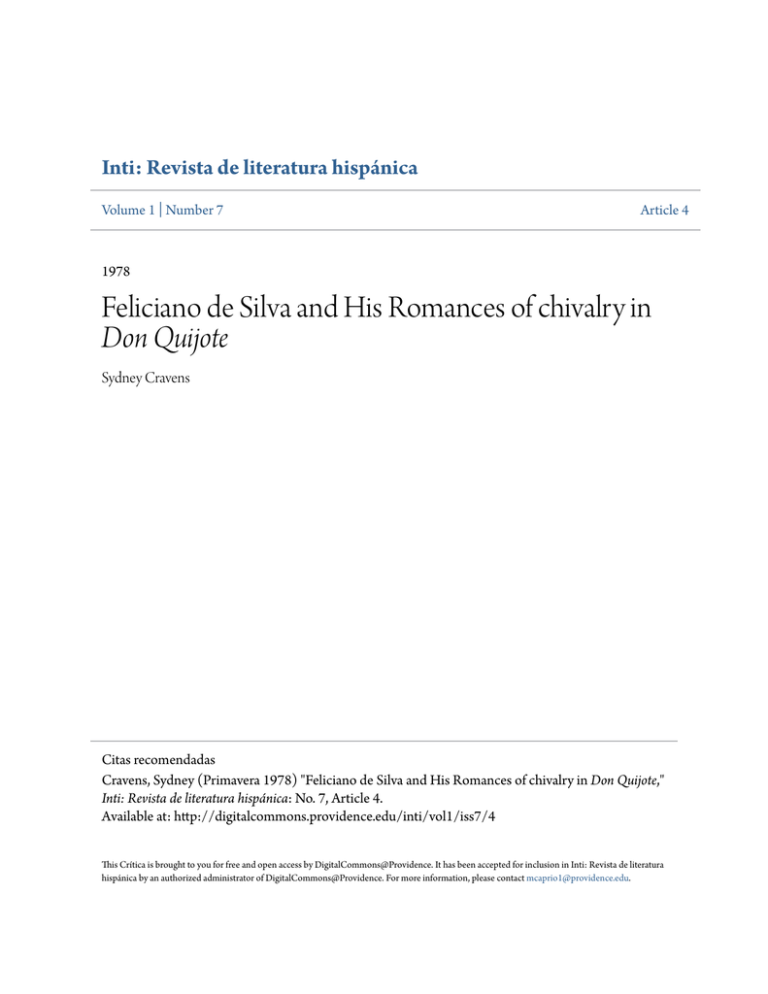
Inti: Revista de literatura hispánica
Volume 1 | Number 7
Article 4
1978
Feliciano de Silva and His Romances of chivalry in
Don Quijote
Sydney Cravens
Citas recomendadas
Cravens, Sydney (Primavera 1978) "Feliciano de Silva and His Romances of chivalry in Don Quijote,"
Inti: Revista de literatura hispánica: No. 7, Article 4.
Available at: http://digitalcommons.providence.edu/inti/vol1/iss7/4
This Crítica is brought to you for free and open access by DigitalCommons@Providence. It has been accepted for inclusion in Inti: Revista de literatura
hispánica by an authorized administrator of DigitalCommons@Providence. For more information, please contact mcaprio1@providence.edu.
FELICIANO DE SILVA AND HIS
ROMANCES OF CHIVALRY IN DON QUIJOTE
Sydney Paul Cravens
Feliciano de Silva, who wrote continuations of Amadis de Gaula, as well
as the Segunda Celestina, has the dubious distinction of being the first author
of romances of chivalry satirized by Cervantes in Don Quijote.1 Cervantes'
ridicule was to be echoed for centuries to come in the derisive remarks of
other critics of Silva's works. In their notes on Cervantes' allusions to Silva
and his books, commentators and editors of the Quijote have only supplied
random examples of Silva's more extravagant style and a few
bio-bibliographical data about him.2 This sketchy information has highlighted
Cervantes' mocking attitude toward Silva's romances, but has not shed much
light on the works themselves, not even on those elements referred to in the
Quijote. A careful identification and analysis of the allusions to Silva's
romances of chivalry in Don Quijote will provide a clearer picture of the
nature of the characters and other features mentioned and should contribute to
a better appreciation of the cervantine satire and irony present in those
passages.
Most readers of Don Quijote readily remember that in the opening pages
of the great novel Silva's romances are named as those which contributed
most to Don Quijote's insanity because of the style exemplified in the famous
"razón de la sinrazón" phrase. Then in the celebrated escrutinio chapter the
Priest also attacks Silva's bewildering phraseology, along with other aspects of
his romances. When the Barber discovers Silva's Amadís de Grecia and other
romances of the Amadis cycle among Don Quijote's books, the Priest orders
emphatically: "Pues vayan todos al corral, que a trueco de quemar a la reina
Pintiquinestra y al pastor Darinel, y a sus églogas y a las endiabladas y
revueltas razones de su autor, quemara con ellos al padre que me engendró, si
anduviera en figura de caballero andante."3 The "endiabladas y revueltas
razones" are not the only facets of Silva's works which stuck most in
Cervantes' memory. The shepherd Darinel and his églogas were also awarded
the prominence of a second mention on the occasion of the conversation
between Don Quijote and Cardenio in the Sierra Morena. The distraught
Cardenio is explaining his beloved Luscinda's fondness for Amadis de Gaula
when Don Quijote interrupts to praise her excellent taste and to suggest: "Y
quisiera yo, señor, que vuestra merced le hubiera enviado junto
con Amadís de Gaula al bueno de Don Rogel de Grecia; que yo sé que
gustara la señora Luscinda mucho de Daraida y Garaya, y de las discreciones
del pastor Darinel, y de aquellos admirables versos de sus bucólicas, cantadas
y representadas por él con todo donaire, discreción y desenvoltura" (II, 237).
Don Quijote's sincere enthusiasm for Silva's romance is evidence of his
mania, and as an ironic expression of Cervantes' satire, works as effectively as
the Priest's direct attack on Silva. Both Don Quijote and the Priest have plenty
to say about Darinel. This means that when Cervantes selected targets for his
satire from among the countless characters who populate Silva's romances of
chivalry, he apparently remembered most vividly a shepherd and his bucolic
poetry, rather than one of the knightly heroes, such as Florisel de Niquea or
Rogel de Grecia.4
A look at Darinel's unusual role in Silva's romances of chivalry will
reveal several reasons he might have attracted Cervantes' attention. Darinel
first appears in the pastoral setting of the final chapters of Amadís de Grecia.
As do the other young shepherds in his village, he loves the beautiful
shepherdess Silvia, who is really a princess, a fact known only to her foster
parents. Darinel is the wealthiest of her suitors and the most accomplished
athlete and musician among them. Nevertheless, Silvia rejects him along with
the others. With that his character soon takes on more eccentric features. He
spends several weeks wandering in the wilds of Babylon, dejectedly singing
and playing his flute (churumbela). When he returns to his village, he is newly
dismayed by the rivalry of prince Florisel de Niquea, who has become a
shepherd in order to woo Silvia. Silvia, however, has fallen in love with prince
Anastarax, after hearing the story of the malicious enchantment under which
he is suffering.5 In the first part of the romance of Florisel de Niquea, Silvia
breaks the spell on Anastarax and marries him after her true royal identity is
revealed. Rather than despairing as before, Darinel is overjoyed to think that
he had aspired to marry such a lofty princess. He adopts the role of a curious
sort of courtly lover, one accepted and appreciated by both Silvia and her
husband because of the pure, spiritual quality of the shepherd's love. Feliciano
de Silva must have placed Darinel in this situation, one based partially on the
Provençal tradition of courtly love, in order to use him later in other episodes
not typical of the romances of chivalry.
As Darinel reappears now and then in the chronicles of Florisel de
Niquea, he evolves into a palace entertainer for Silvia and other royal
characters, who especially enjoy his discourses on love. His listeners are impressed by his explanations of the absence of any physical desire in his
feelings for Silvia. He assures them all that he now adores her in a contemplative, spiritual manner and considers this a reward in itself (Florisel I, fols.
45vb and 83ra). Now this rather neo-Platonic sentiment, which points toward
the pastoral novel, is a noticeable contrast to typical love affairs of the
chivalric heroes, who are wont to seduce their ladies-fair, no matter how
idealized and true their sentiments. In this respect, Darinel's almost Platonic
variation on the love theme within these romances of chivalry could well have
been a reason to catch the attention of Cervantes, some of whose own works
include Platonic love affairs between young characters of apparently different
social stations.
Within his role of courtly entertainer, Darinel frequently delights his
audience with his music and poetry. In almost all the episodes in which he has
a part, Darinel plays his flute and sings (Amadís de Grecia, fol. 227va-b;
Florisel I, fols. 27vb, 45vb and 81rb). However, most of his songs or poems
are merely mentioned. Only a few of those actually interpolated in the
romances of Florisel de Niquea belong to Darinel, and none of his poems is
an eclogue.6 Therefore, the Priest and Don Quijote are in error when they
allude to the églogas or bucólicas of Darinel. The truth is that the bucólicas of
the fourth part of Florisel de Niquea are composed and sung by the shepherd
Archileo, who is none other than Rogel de Grecia, the hero of this romance, in
disguise.7 It is through the allegorical language of his eclogues that Rogel is
able to court the highly protected empress Archisidea, who finally becomes
his wife. Archisidea's royal country retreat is an elaborate bucolic setting for
Archileo's (Rogel's) eclogues and other artificial pastoral amusements.
Because of these features and the relatively extensive portions of the book
dedicated to them, the fourth part of Florisel de Niquea should be considered
as a more significant antecedent of the pastoral novel than even the Amadís de
Grecia episode (see Cravens, Feliciano de Silva, pp. 75-108). Cervantes was
probably thinking of those scenes in the fourth part of Florisel when he wrote
of the églogas and bucólicas his characters mistakenly attributed to Darinel.
The confusion was almost certainly Cervantes'. There would seem to be no
artistic purpose served by deliberately having the Priest and Don Quijote
make such a mistake, which is of no importance to the Quijote. This suggests
that Cervantes had read the fourth part of Florisel only long before writing
Don Quijote, and didn't have it fresh in mind. Cervantes' hazy recollection
does reveal, at least, that he had taken particular notice of Feliciano de Silva's
intertwining of the chivalric and pastoral modes in his romances.
One aspect of the chivalric-pastoral mixture in Silva's romances could
hardly fail to have attracted Cervantes' attention. At the same time Darinel
earns the esteem of the court through the ennobling qualities of his love, he
also develops into a comic character. During the time he accompanies Florisel
and Silvia on their adventurous trek in search of Anastarax, Darinel is
exposed to unaccustomed dangers, to which he reacts by cringing or running
away in fear. Then to explain his cowardly actions, he invents far-fetched
excuses which make his companions laugh (Amadis de Grecia, fol. 231ra).
This comic trait of cowardice soon disappears from Darinel's personality in
the chronicles of Florisel de Niquea, but he acquires other humorous
attributes. He and his friend Mordacheo, a gigantic orchard keeper, engage in
jovial wrestling matches for the amusement of Florisel and
the princesses Elena and Timbria (Florisel I, fol. 42ra). The comic function of
Darinel and Mordacheo is developed even more in their verbal jousts. Since
Mordacheo is a true rustic whose materialistic tastes are along the order of
those of Sancho Panza, he expressed little sympathy for Darinel's idealized
love for Silvia.8 He often ridicules Darinel's extatic disquisitions on that
subject. Darinel, in turn, belittles the lack of imagination of the rather
dull-witted Mordacheo (Florisel I, fol. 83ra and III, fol. 152ra).
Darinel's physical appearance is also the butt of joking remarks. On
several occasions his friendly antagonists mischievously liken his mop of
graying hair to an enormous white fleece of wool (Florisel I, fols. 39va and
81va; II, vol. 220vb; and III, fol. 8va). In one amusing episode Darinel and the
dwarves Bufendo and Ximiaca exchange insults dealing with the shepherd's
fleece-like hairstyle and the dwarves' ugliness and diminutive size (Florisel
III, fol. 59ra-b). Because of his superior wit, Darinel usually gains the
advantage in these farcical scenes, in which his comic function is made
obvious by the laughter of the royal onlookers.9
There is intended humor to be found also in Darinel's affected speech,
which both amuses and amazes the other characters in Silva's books, just as it
does the modern reader. This is due primarily to Darinel's elaboration and
exaggeration of topics and conceits typical of the fifteenth century cancionero
poetry. For example, he claims that his lady Silvia dwells in his heart, while
his thoughts and spirit never part from her; consequently, he calls out
greetings to himself when he arrives in her presence, and asks her to welcome
herself by embracing him (Amadís de Grecia, fol. 230ra; Florisel I, fol. 84va).
Another of Darinel's favorite conceits is to praise each facet of Silvia's beauty
in terms of an idyllic landscape (Florisel II, fols. 211ra and 239va). He also
allegorizes the processes of his feelings for Silvia with symbols chosen from
the bucolic setting. For example, to illustrate the glory he has attained through
his exalted love for Silvia, after having lost all hope of recompense, Darinel
proclaims: "floreci con me secar . . . Puedo apacentar los pensamientos
donde, por mas agostar las yervas de mi esperança en las flores de su desseo,
las pudieron apretar. Pues, o glorioso Darinel, regozijaste en estos prados de
tu poca esperança bañados de las fuentes de tus lagrimas . . ." (Florisel II, fol.
211ra). Such flights of exaggerated eloquence are the delight of Darinel's
courtly listeners. Cervantes may have been satirizing these expressions when
he ironically had Don Quijote attribute the qualities of "donaire, discreción y
desenvoltura" to Darinel.
After reading the foregoing excerpts, one should not be surprised to learn
that it is Darinel, as much as or more than any other single character in Silva's
romances of chivalry, who expresses himself with the "endiabladas y
revueltas razones" which warp poor Don Quijote's mind. In the fourth part of
Florisel de Niquea, Darinel utters what surely must be the closest model for
Cervantes' famous "razón de la sinrazón" phrase to be found in Silva's
romances: "Essas razones y sinrazones—dix o Darinel—no las busqueys en
aquel [sic] tan poca razon en ella como en la sinrazon pudo contino guardar:
pues teneys en mi esperiencia de aquella sinrazón que mi señora la princesa
Silvia puede gozar de la razon de mi conocimiento de su hermosura para mis
gloriosos pensamientos—y con esta ataja sus razones."10 It is not surprising
that when the Priest mentions Darinel he also repeats Cervantes' jibe at Silva's
extravagant style. But it must be noted that Silva himself had made his
characters, even Darinel, laugh at these ridiculous speeches as if they
themselves were aware of the parody and humor therein. Silva evidently
expected his readers to react in the same manner.11 Cervantes may have
chuckled at some of these attempts at humor in Darinel's language or he may
have only felt some disgust at their absurdity. At least he remembered them.
Of course Don Quijote tried to read them logically and the effort helped to
drive him crazy.
The likelihood that Cervantes remembered the shepherd Darinel partly
because of the latter's comic features is strengthened by an examination of the
other characters of Silva's romances mentioned along with Darinel in the
Quijote. Daraida and Garaya, who Don Quijote felt were sure to please
Cardenio's beloved Luscinda, were correctly identified by Clemencín in the
following note to his edition of Don Quijote: "Daraida era el Príncipe
Agesilao, hijo de D. Falanges y Alastrajarea, y Garaya D. Arlanges, Príncipe
de España. Agesilao y Arlanges, enamorados de la Princesa Diana por un
retrato suyo que vieron en Atenas, donde se hallaban estudiando, y no
sabiendo como verla y tratarla, discurrieron vestirse de mugeres, para poder
con este disfraz servir en calidad de doncellas a Diana en la ínsula Guindaya,
donde la criaba con sumo recato su madre la Reina Sidonia. Así lo
consiguieron, ayudándoles su juventud y hermosura, y resultando los extraños
y nunca vistos ni imaginados sucesos que se refieren en dicha crónica
(Florisel III, cap. 14 y siguientes)" (I, 266-67n.). The transvestite disguises of
these two princes must have seemed humorous, even absurdly so, to many
readers of Silva's romance. Silva himself poked fun at the episode by having
Agesilao and Arlanges laughingly comment on their adventures as Daraida
and Garaya when Diana and her maidens are not present.
When Don Quijote's friend the Priest emphatically condemned Queen
Pintiquinestra to the bonfire along with Darinel, he was probably prompted to
do so by the queen's unusual name itself. Pintiquinestra appears to be a
combination of parts of two names drawn from ancient mythology.
Pintiqui-was quite likely suggested by the beginning of Penthesilea, the name
of the Amazon queen who came to the aid of the Trojans toward the end of
the Trojan War.12 The fact that Pintiquinestra herself is an Amazon queen
when she first appears in the Amadís cycle supports this assumption.13 The
ending -nestra must have been suggested by Clytemnestra, Agamemnon's
wife, or Hypermnestra, the Danaïd. A reader so sensitive to the special or
unusual effects of some proper names as was Cervantes would certainly have
been amused by such a contrived specimen as Pintiquinestra.14
This investigation of Cervantes' specific mentions of characters and other
features from the romances of Feliciano de Silva reaffirms the long-held and
obvious opinion that Cervantes was ridiculing some of the most absurd
aspects of Silva's romances (Daraida and Garaya, "la razón de la sinrazón,"
etc.). It further suggests that Cervantes best remembered not just what seemed
absurd, but more especially what was comical or was meant to be comical
(certain proper names, Darinel's antics, etc.). Cervantes' recollections of
Silva's mixture of the chivalric and pastoral modes was no doubt enhanced by
the humor and parody represented by Darinel and his speech. This is not to
suggest that Silva's works especially influenced Cervantes in writing Don
Quijote. Indeed it continues to appear that Cervantes generally did not admire
Feliciano de Silva's romances of chivalry, but he could well have appreciated
their potential for imaginative narrative and amusing burlesque and parody.
NOTES
1. Limited bibliographical information about Silva's works may be found in Henry Thomas,
Spanish and Portuguese Romances of Chivalry (Cambridge: Cambridge University Press,
1920), pp. 69-70 and 72-76. More complete and current information may be consulted in
Daniel Eisenberg's introduction to his edition of Silva's Amadís de Grecia, in preparation at
the time this study was completed. Following is a list of the editions of Silva's romances
quoted in the text of this study, with dates of first editions along with the abbreviated titles to
be used: (1) Amadts de Grecia (1530)—La cronica del muy valiente y esforçado príncipe y
cauallero de la Ardiente Espada Amadts de Grecia (Sevilla: Cromberger, 1542); (2) Florisel
I and II (1532)—La cronica de los muy valientes caualleros don Florisel de Niqueay el
fuerte Anaxartes (Lisboa: Marcos Borges, 1566); (3) Florisel III (1535)—Parte tercera de la
crónica de Florisel de Niquea (Sevilla: Cromberger, 1546); (4) Florisel IV, 1o.
(1551)—Cuarta parte de don Florisel de Niquea first book, (Salamanca: Andrea de
Portonaris, 1551); (5) Florisel IV, 2o. (1551)—Segundo libro de la quarta parte de la
crónica de Florisel de Niquea (Zaragoza: Pierres de la Floresta, 1568).
2. Little, if anything, has ever been added to the information furnished by Diego Clemencín in
notes to his edition of Don Quijote (Madrid: E. Aguado, 1833-39), I, 5n. and 112-13n. and II,
266-67n.
3. Edición crítica de Francisco Rodríguez Marín (Madrid: Atlas, 1947-49), I, 193-94. All
references to the text of Don Quijote are to this edition.
4. Only Silva's hero Amadís de Grecia, because of his epithets Caballero de la Ardiente Espada
and Caballero de la Muerte, is mentioned in Don Quijote (I, 87-88 and II, 31 and 75). The
Duke cites the Alastrajareas, along with the Orianas and Madásimas, as examples of ladies of
royal lineage (VI, 51). Alastraxarea, a character created by Silva, was Florisel's half-sister, an
Amazonic princess who helped Silvia break the spell on Anastarax in the first part of Florisel
de Niquea.
5. This episode has been told in résumé form by Clemencin, I, 112-13n., and by Pascual de
Gayangos, in the prologue to his edition of Libros de caballerías, I, BAE, 40 (Madrid:
Rivadeneyra, 1857), xxxi. It has been studied by Juan Bautista Avalle-Arce in La novela
pastoril española (Madrid: Revista de Occidente, 1959), pp. 25-30; Francisco López Estrada
in Los libros de los pastores en la literatura española, I: la órbita previa (Madrid: Gredos,
1974), 323-39; and Sydney Cravens in Feliciano de Silvay los antecedentes de
la novela pastoril en sus libros de caballerías (Chapel Hill: Estudios de Hispanófila, 1976),
pp. 39-74. It may soon be read in Daniel Eisenberg's edition of Amadts de Grecia, in
preparation.
6. Darinel sings two pastoral poems in coplas de arte mayor in Florisel I, fol. 27va-b and in
Florisel IV, 2°., fol. 134rb-va. Homero Serís reproduced the first of the two in Nuevo ensayo
de una biblioteca española de libros raros y curiosos, I (New York: The Hispanic Society of
America, 1964), 76.
7. Clemencín failed to correct Cervantes. He merely mentioned the bucólicas by Archileo in the
first book of the fourth part of Florisel He did not indicate that Archileo was Rogel's false
identity. It appears that Clemencín had not read the second book of the fourth part of Florisel,
in which he would have found even more of Archileo's bucólicas. For Clemencín and for
most later critics of the romances of chivalry, Florisel HI is what Cervantes meant by Rogel
de Grecia, the work praised by Don Quijote. This may well not be the case. While the
adventure of Daraida and Garaya belongs to Florisel III, the bucólicas appear only in Florisel
IV. In addition, Rogel de Grecia is clearly the dominant hero in Florisel IV, whereas in
Florisel III he shares center stage with other knights.
8. Mordacheo is much more interested in food. His nostalgic longing for the simple meals and
other pleasures of rustic life are topics of his discourse on the "menosprecio de corte y
alabanza de aldea" theme in Florisel III, fol. 9ra.
9. Maxime Chevalier suggested a study of the burlesque elements in Silva's romances in
L'Arioste en Espagne (Bordeaux: Feret & Fils, 1966), p. 255. This was done, to some extent,
by way of the French translations of Silva's books, by John J. O'Connor in his Amadis de
Gaule and its Influence on Elizabethan Literature (New Brunswick, N. J.: Rutgers University
Press, 1970). Unfortunately, whether through the fault of the French translators or of
O'Connor, the latter's book contains some inaccuracies. He views Darinel as little more than a
cowardly buffoon (pp. 101, 168, 191 and 235), and calls the giant Mordacheo (Mardoquée) a
dwarf. O'Connor's book received some critical remarks in a review article by Edwin B. Place
in HR, 41 (1973), 427-30, and a quite severe review by Daniel Eisenberg in Hispanófila, no.
45 (1972), 83-85.
10. Florisel IV, 2°., fol. 219rb. Cervantes' parody reads: "La razón de la sinrazón que a mi razón
se hace, de tal manera mi razón enflaquece, que con razón me quejo de la vuestra fermosura"
(I, 81-84). There is another fully developed example of this same adnominatio in Silva's own
Segunda Celestina—see María Chamorro Fernández: edition (Madrid: Ciencia Nueva, 1968),
pp. 25-26. Nevertheless it should be remembered that Cervantes was speaking of Silva's
romances of chivalry when he interpolated his invented passage.
11. Similar "author's comments" on the fictitional bystanders' laughter are seen by P. E. Russell as
one more element of proof of Cervantes' comic intent in the Quijote. See Russell's "Don
Quijote as a Funny Book," MLR, 64 (1969), 319 and 320.
12. Cf. the prefixes in the names of Silva's characters Archileo and Archisidea. Names such as
these could have suggested that of Altisidora in the Quijote.
13. Pintiquinestra appears in the seventh book of Amadis, Lisuarte de Grecia, published in Seville
in 1514. In his prologue to Amadis de Grecia Silva claims to be the author of Lisuarte. Like
Penthesilea, Pintiquinestra is an Amazon queen {Lisuarte, ed. Lisbon, 1587, fol. 31vb). Later
in the same book she marries Perión de Sobradisa, son of Galaor (fol. 90ra).
14. See Howard Mancing, "The Comic Function of Chivalric Names in Don Quijote, " Names, 21
(1973), 220-35, for a discussion of this subject (but not Pintiquinestra). Eisenberg has shown
that Don Quijote's friend the Priest seems to have dwelt especially on characters and episodes
of the romances of chivalry that he viewed as humorous—see "Pero Pérez the Priest and His
Comment on Tirant lo Blanch," MLN, 88 (1973), 321-30. That Cervantes probably
considered Pintiquinestra as a comic name was first suggested to me by Herman Iventosch.
